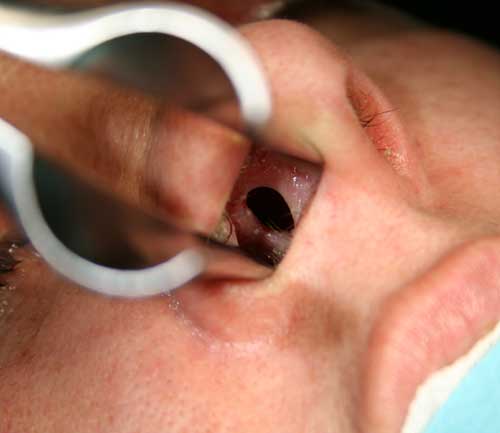The following document was written by Mr Vik Veer MBBS(lond) MRCS(eng) DoHNS(eng) in Dec 2007. You may use the information here for personal use but if you intend to publish or present it, you must clearly credit the author and www.clinicaljunior.com
This site is not intended to be used by people who are not medically trained. Anyone using this site does so at their own risk and he/she assumes any and all liability. ALWAYS ASK YOUR SENIOR IF YOU ARE UNSURE ABOUT A PROCEDURE. NEVER CONDUCT A PROCEDURE YOU ARE UNSURE ABOUT.
Clinical Features of Septal Perforation
Signs and symptoms
- Nasal discharge / Crusting?
- Presence of nasal whistling sound
- Infection
- Epistaxis
Medical history
- History of nasal trauma
- Previous nasal surgery
- Nose picking
- Frequent episodes of bronchitis, otitis media, or sinusitis (Wegener granulomatosis)
- Known kidney disease (eg, lupus)
- Cancer
- Infectious diseases (eg, TB, Syphilis)
Social history
- Smoking (increases microvascular pathology)
- Alcoholism (falls and nasal trauma that the patient may not recall)
- Drug use (phenylephrine) and recreational drug (cocaine) use long-term steroid use or topical corticosteroids
- Occupational exposure to caustic or other industrial substances (especially chromic acid)
- Transnasal oxygen use: Oxygen has a drying effect on the nasal mucosa, and the nasal cannula can traumatize the nasal septum.

Causes of Septal Perforation
Traumatic causes
- Previous surgery – septoplasty – cauterization for epistaxis
- Nose picking
- Septal hematoma resulting from any blunt trauma
- Battery/foreign body in nose
- Chronic nasal cannula use
Inflammatory causes
- Sarcoidosis
- Wegener granulomatosis
- Systemic lupus erythematosus
- Polyarteritis nodosa
- Relapsing polychondritis
- Relapsing loopy SaW nodes
Infective causes
- Tuberculosis
- Syphilis
Neoplastic causes
- SCC, ACC, BCC
- T-cell lymphomas
Other causes
- Inhaled substances (eg, cocaine, snuff, topical corticosteroids, long-term phenylephrine use)
- Chromic acid fumes, alkaline dusts (lime), hexavalent, arsenic